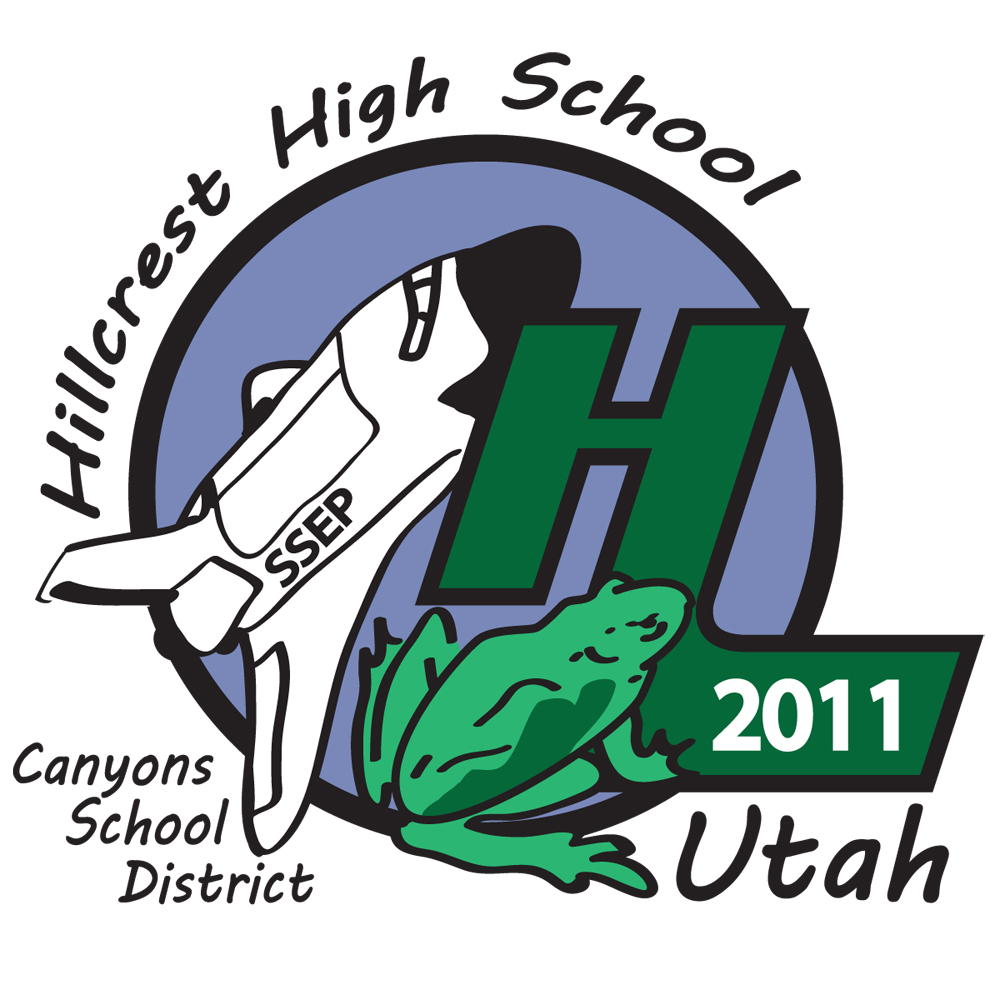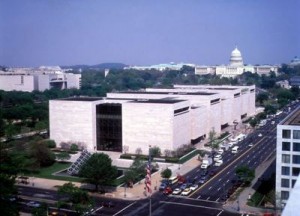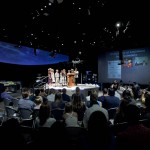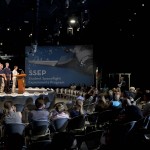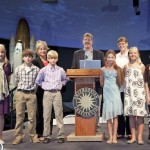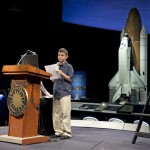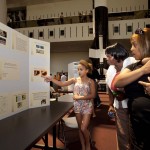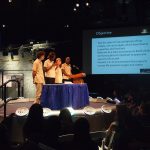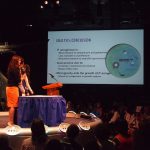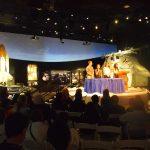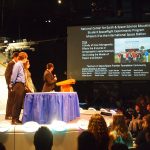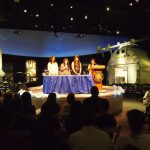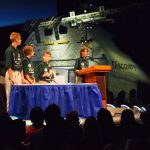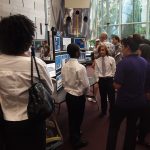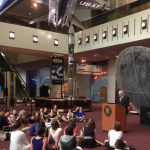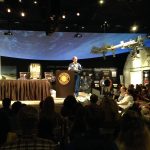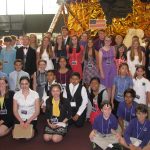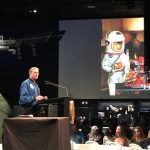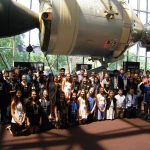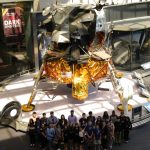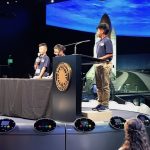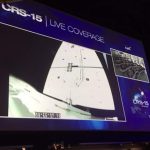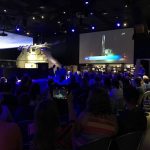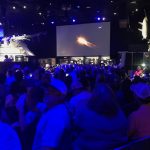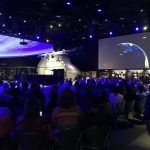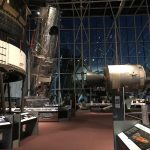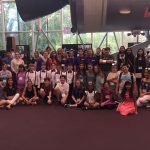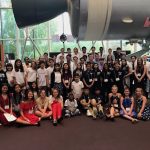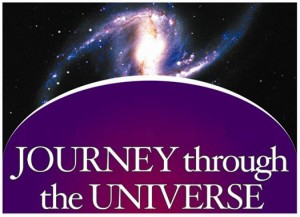NOTE: This is a sub-page of the More on SSEP main page which you should read first.
We believe that the excitement surrounding a community-wide competition to fly an experiment aboard the International Space Station should be leveraged into a celebration of the joys of learning, the nature of human exploration, and a broader commitment to STEM education that is strategically tuned to local curricular need. We have therefore embedded the Flight Experiment Design Competition within a programmatic framework that can engage grade K-16 students, their teachers, their families, and the public across your community, and that allows the experience of the community competition to be shared with even national audiences.
Below is a list of the Community Program elements (they are provided as part of the Baseline Program Cost unless otherwise noted)—
1. General Program Resources
 The Main SSEP Website
The Main SSEP Website
This website, which serves as a comprehensive clearing house for SSEP program information. This website also contains the SSEP National Blog, which provides the latest program news and updates, and also serves as a showcase for community experiences. Subscribe to the Blog on the SSEP Home Page to keep up-to-date.
 SSEP Community Network Hubsite
SSEP Community Network Hubsite
The Community Network Hubsite provides an online gathering spot to explore all SSEP activities across the network of participating communities. The Hubsite includes Community Profiles; a SSEP In the News page providing links to media coverage across the nation; a SSEP In Our Own Words page, providing a sense of program impact from the leadership, teachers, and students in participating communities; a showcase for Experiments Selected for Flight; and the student-designed Mission Patches selected to fly along with the flight experiments (see Section 2 below). If you want to keep up with the world of SSEP, the Hubsite is the place to go.
Conference Video Archive of All Student Team Presentations
You can watch videos of student team oral presentations at the Annual SSEP National Conference held each June/July at the Smithsonian National Air and Space Museum, in Washington, DC. The archive includes all student presentations since the Conference was first launched in 2011. The archive is found in the Scientific Return and Reporting section at the Hubsite.
Videos Showcasing SSEP that Were Created by the Participating Communities
You can watch videos that were created by SSEP communities to, e.g., document the student and community experience, build program awareness, and assist in fundraising. Visit the Showcase of Community-Created Videos at the Hubsite.
2. Mission Patch to Fly in Space—A Student Design Competition
Community-wide engagement, and cross-disciplinary learning are also cornerstone objectives for SSEP in the context of the embraced Learning Community Model for STEM education, and our effort to be true to the interdisciplinary nature of real research. In this spirit, and continuing the tradition of SSEP started on the final flights of Space Shuttles Endeavour (STS-134) and Atlantis (STS-135), we’re providing the opportunity for you to conduct an art and design competition across your community—for a large number of students —to create a Mission Patch—a paper 3.5-inch x 3.5-inch square emblem that captures your SSEP experience. We will then fly your winning Mission Patch in space as part of the payload containing your experiment, and it will be returned to you embossed with a certification stating that it flew in space. The mission patch competition is also an opportunity to keep community-wide excitement alive post experiment selection while we’re all waiting for launch, and a means to extend the program in an interdisciplinary manner to engage, e.g., classes in art and design, and history.
A historical note: Mission patches have been part of human spaceflight since the days of Project Mercury in the 1960s (see, e.g., this page at the NASA History Program Office). Each Space Shuttle crew worked with a NASA designer to create a mission patch. The SSEP Mission Patch competition therefore allows communities to engage in another authentic aspect of the space program, and broadens SSEP to be more appropriately designated as a STEAM education initiative – Science, Technology, Engineering, Art, and Mathematics.
Seen above is the Mission Patch from Canyons School District, Utah, which flew with their experiment on STS-134, the final flight of Space Shuttle Endeavour. Click on the photo to see their Mission Patch up close and personal. Across the first 18 SSEP flight opportunities, through Mission 16 to ISS, 160,426 Mission Patch designs were received, reflecting 189,000 grade preK-16 students engaged in the SSEP art and design competitions. Many communities turn the winning patch design into a cloth patch or lapel pin (we provide links to possible vendors), and use it as a design to ‘brand’ their involvement in SSEP. Visit the Community Network Hubsite to see all the Mission Patches that have been selected and flown in space.
While the mission patch competition should be open to at least the students participating in the SSEP experiment design competition—which is limited to grades 5-16—we strongly encourage each community to broaden participation by opening the mission patch competition to wider student involvement across grades K-16, to classes beyond STEM disciplines, and to student groups across your community—even the community beyond your school. The idea is COMMUNITY ENGAGEMENT with hundreds to thousands of your students given the opportunity to participate. You should view the mission patch competition as one way your entire community can celebrate involvement in this program, and become aware of your student scientists designing real microgravity experiments for the International Space Station.
We will also consider flying two patches for a community to accommodate potentially two mission patch competitions, e.g., one for lower grades (grades K-4) and one for upper grades (grades 5-12).
3. SSEP Multimedia
A few sections below the top of the homepages at the Main SSEP website, and at the SSEP Community Network Hubsite, is a section titled “SSEP / International Space Station Multimedia”, which includes currently 4 multimedia resources, each accessible by opening up a ‘toggle’. The multimedia section is meant to provide SSEP students, teachers, and their communities a real world connection to the International Space Station (ISS), its crew, and the fact that this vehicle is right now traveling over the Earth at an altitude of 260 miles (47 times higher than Mt. Everest), at the fantastic speed of 4.5 miles per second (17,000 mph or 27,600 km/hr). ISS is the size of a football field, and is one of the most complex machines the human race has ever built. This ‘backstory’ makes all the more inspirational – to entire communities – that ISS is where your SSEP flight experiment is conducted by the astronauts.
In the Multimedia section, you can –
- track ISS’s current location over the Earth
- see live video from ISS looking down on the Earth
- read Tweets live from the astronauts aboard ISS, and
- find out when ISS is next flying over your community using Spot the Station
You may not know this, but the International Space Station is the second brightest object in the night sky after the Moon, and has been flying over your head in plain sight (and likely unnoticed) for many years. NASA’s Spot the Station website has been allowing the general public to determine when Station will be flying overhead, and even allows you to sign up for email notification in advance of a Station over-flight of your community.
In late 2015, the National Center for Earth and Space Science Education suggested to NASA Headquarters that a Spot the Station widget, which could be easily embedded on any website, would be a wonderful way to extend ISS public awareness. The widget at right was the result, and you’ll note that it is also found in the right column on all main pages of the SSEP websites.
You are invited to use the widget to explore Station over-flights of your community, and even embed this widget on your website by clicking on the “About” button in the widget.
4. A National Conference in Washington, DC
Note: This is a Supplemental Program Option since a conference registration fee per attendee may be required. A registration fee is not covered in the Baseline Program Cost. In addition, all travel costs, including airfare, hotel, meals, and miscellaneous travel, are the responsibility of the attendees.
A SSEP National Conference will be held in the nation’s capital where students from all communities participating in the SSEP can present on their experiment designs, and those teams that flew experiments can report preliminary results. We want to immerse students in the experience of a science conference. It is fitting. If the SSEP is dedicated to letting students step into the shoes of scientists and engineers, then a conference should be part of the experience.
The 2011 through 2019 Conferences were held at the Smithsonian National Air and Space Museum, one of the most visited museums on the planet, and with no registration fee. The conferences take place at either the Museum’s building on the National Mall, in downtown Washington, DC, or at the Stephen F. Udvar-Hazy Center in Chantilly, VA, the Museum’s annex at Dulles Airport. Student teams present to their peers using power point presentations. The visiting public is invited to watch the conference as part of the museum visitorship experience. Student teams also present to the public via poster presentations. Visit the SSEP National Conference page for more information.
The conference will include featured presentations by nationally recognized space scientists and engineers who will passionately talk about exploration, and hopefully inspire many young women and men in the audience to follow in their footsteps. Visit the archive Videos of Conference Featured Presentations.
Due to the Covid pandemic no conferences could be held in 2020-22. The expectation is that the annual conference will re-start in 2023.
NCESSE has been conducting powerful science education programs in partnership with the Museum’s Education Division for 25 years.
Click to zoom in on the Conference photos below.
- 2011 – oral presentation, Zachary, LA
- 2011 – oral presentation, Jefferson County, KY
- 2011 – oral presentation, Zachary, LA
- 2011 – oral presentation, Lincolnwood, IL
- 2011 – storyboard presentation, by team from Ballston Spa, NY, in Space Race Gallery
- 2013 – oral presentation, Russell County, VA
- 2013 – oral presentation, San Marino, CA
- 2013 – oral presentation, Fitchburg, MA
- 2013 – oral presentation, team from Teachers in Space
- 2013 – oral presentation, Cicero, IL
- 2013 – oral presentation, Huron County, IL
- 2013 – storyboard presentation. by team from East Lyme, CT, in Space Race Gallery
- 2014- General Jack Dailey, Museum Director, addresses attendees
- 2014 – astronaut Don Thomas
- 2014 – student researchers Day 1
- 2017 – astronaut Don Thomas
- 2017 – student researchers Day 1
- 2017 -student researchers Day 2
- 2018 – oral presentation, Winnipeg, Manitoba
- 2018 – SpaceX-15 with Mission 12 experiments, just so happens to launch during Conference
- 2018 – Launch of SpaceX-15 at 6:54 am ET, June 29, 2018
- 2018 – Museum sets precedent, opens at 5:00 am just for attendees to watch
- 2018 – SpaceX-15 Dragon in orbit with 34 Mission 12 experiments, 7 teams in audience watch their experiments orbit the Earth
- 2018 – before delegates arrive for evening program
- 2018 – student researchers Day 1
- 2018 – student researchers Day 2
5. Community-Wide Programming by a National Team of Scientists and Engineers
Note: This is a Supplemental Program Option, and is not covered as part of the Baseline Program Cost
Your community can host—for up to a week—a National Team of scientists and engineers to celebrate the accomplishments of ALL the students engaged in the Flight Experiment Opportunity, and to serve as role models and heroes to America’s next generation of scientists and engineers.
The researchers on the National Team are from research institutions across the nation—and these are scientists and engineers who are selected because they are passionate about their research and gifted at communicating that passion to audiences of all ages.
The programming is delivered through NCESSE’s Journey through the Universe national initiative, which embraces a Learning Community Model for science education. In each community, classroom visits by the National Team for up to thousands of students—one classroom at a time, and presentations to families and the public, provide an authentic view of the nature of science, the lives of modern-day explorers, and the educational pathway to the frontier. The hallmarks of the visits and presentations are audience participation, very personal and personable stories of exploration, and embracing the notion that science is organized curiosity—the art of posing a question, crafting a pathway to an answer, and reveling in learning something wholly new. The family and public presentations can also serve as venues where the community as a whole can honor all the student teams that proposed flight experiments, and where awards can be bestowed for participation in the Student Spaceflight Experiments Program.
Programming can also include a 1-day workshop for 30 to 200 educators at any grade level, customized to local curricular need, and capable of addressing a variety of topics, including: use of inquiry-based learning in the classroom, and experimental design. Additional day-long workshops to week-long summer institutes can provide training on grade K-12 compendia of lessons in the Earth and space sciences, spaceflight, and space engineering that are designed to national science education standards.
Through choice of available content and programming resources, communities small and large can create a customized Journey through the Universe program that reflects their strategic needs in STEM education; can be delivered systemically across an entire school district; and is designed to be sustainable.
Visit the Journey through the Universe page at the NCESSE website as a one-stop-shop for program details, including a comprehensive set of links to pages on program design, pedagogy, assessment, available content, connections to standards and NCLB, and to extensive testimonials from the educational leadership in communities across the nation.
As a benchmark: consider a Team of 3 researchers traveling to a community for a week of Classroom Visits, Monday through Friday mid-day, with arrival on Sunday, and departure Friday afternoon. The Team could conduct a maximum of 65 class visits, of typically 45 minutes each. If each visit is to a class of 30, then 1,950 students could be engaged. If each visit is to a double class, then the audience could be nearly 4,000 students. The Team could also conduct 1 or 2 Family and Public Programs for the community. Baseline Assessment would be conducted for both the Classroom Visits and Family and Public Programs.
Return to More on SSEP main page?

